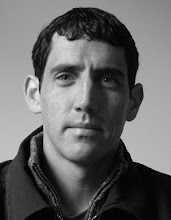
Christoph Niemann's Lego art in the New York Times, which I posted about before, has proven a rich vein.
The title of his blog, Abstract City, got me thinking about abstraction as an aspect of art, writing and expression in general. It's like reading about a cool new car and suddenly noticing them everywhere.
I've happened upon all sorts of discussion of abstraction. (In other news, I had a discussion about unicycles with a friend recently, then saw a woman practicing unicycling on a winter day in front of her house here in Princeton.)
The thing I found most striking in Niemann's Lego art, as I mentioned before, was the size of the pepper grinder toted by the Lego waiter. To rehash: "The size of the grinder makes the art sublime by raising it from simple imitation of reality to the level of satire -- how pretentious are those huge restaurant salt shakers anyway!?"
Then there's this quote by the Latvian-born American abstract painter Mark Rothko: "I’m not an abstractionist. I’m not interested in the relationship of color or form or anything else. I’m interested only in expressing basic human emotions: tragedy, ecstasy, doom, and so on."
(I was reading about Rothko because Niemann included an homage to him in a proposed tile mosaic in his remodeled bathroom.)
The common thread here, at least the one I've noticed, is that abstraction not only serves as a way to represent objects, feeling or ideas, but also, at its best, communicates some essential truth about the human experience.
Rothko put it this way: "It is a widely accepted notion among painters that it does not matter what one paints as long as it is well painted. This is the essence of academicism. There is no such thing as good painting about nothing."
One can imagine a painter sitting at her easel next to a canal, capturing the fall foliage reflected in the water's surface. How is this any different than filling in a color-by-numbers depiction of the same scene? Is there any difference, other than resale value, if both are simply imitative?
If she's there on doctor's orders to lower her blood pressure, she may shrug off the question. If she's there to learn to communicate some deeper truth about nature and her relationship to it, the question is crucial and potentially devastating if she can't find a way to answer it.
Of course, one difference between painting "freehand" and coloring by numbers are the constraints placed on the artist's craft. With no lines to guide her the artist must rely more on her own judgment and skill to convey what she sees to the canvas. That also allows her more freedom to develop a system for communicating visually.
For Rothko, as with other artists, this freedom allowed his craft to evolve over time to express the emotions and concepts the artist thought important. Throughout his career, Rothko's work became increasingly abstract and easily identifiable objects disappeared from his canvases.
From an exhibit website:
During the 1940s Rothko's imagery became increasingly symbolic. In the social climate of anxiety that dominated the late 1930s and the years of World War II, images from everyday life -- however unnaturalistic -- began to appear somewhat outmoded. If art were to express the tragedy of the human condition, Rothko felt, new subjects and a new idiom had to be found. He said, "It was with the utmost reluctance that I found the figure could not serve my purposes....But a time came when none of us could use the figure without mutilating it."
The idiom for which Rothko is best know are paintings characterized by simple asymmetric shapes and layers of liquid color.
For him, eschewing representation permitted greater clarity, "the elimination of all obstacles between the painter and the idea and between the idea and the observer." As examples of such obstacles, Rothko gave "memory, history, or geometry, which are swamps of generalization from which one might pull out parodies of ideas (which are ghosts) but never an idea in itself. To achieve this clarity is, inevitably, to be understood."
As I interpret it, Rothko was avoiding recognizable objects in an effort to capture some visceral impression that correlated with the archetypal emotions captured in myth: terror, hate, bliss and other feelings for which their are no names. (Jungian psychology was a key influence on the abstract expressionists - Rothko's pedigree as taught in art history classes.)
His paintings were abstract (thought he didn't like that word) in that they were about, intending to capture and in capturing to evoke, deep-seated human emotions. The emotions were the objects of the abstraction.
Over time Rothko experimented with new mechanisms for communicating those emotional truths -- an evolution seen in over the course of many artists' careers.
My guess is that what Rothko disliked about the word "abstract" is that in connotes simple "imitation." He wanted people to understand that his Lego men were all bent under the weight of an absurdly large pepper mill.




No comments:
Post a Comment